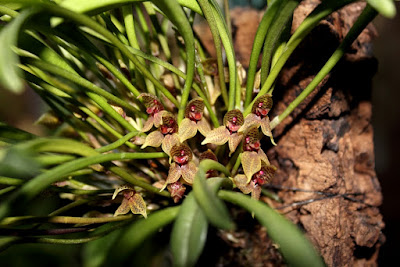Dryadella simula is native to Central and South America; in particular it is found in Colombia, Ecuador and Peru. It populates the mountainous areas, growing in the humid woods at high altitudes from 2000 to 3100 meters...
Dryadella simula also called as The Pug Nosed Dryadella, Dryadella popayanensis, Masdevallia popayanensis, Masdevallia simula, is a species of the genus Dryadella. This species was described by Carlyle A. Luer in 1978.
IDENTIFY DRYADELLA SIMULA
Dryadella simula is native to Central and South America; in particular it is found in Colombia, Ecuador and Peru. It populates the mountainous areas, growing in the humid woods at high altitudes from 2000 to 3100 meters.
It is a mini-miniature sized, cold growing, epiphytic herb without pseudobulbs and has terete ramicauls enveloped by close, tubular, scarious, up to 7 cm long sheaths that are soon evanescent carrying a single, apical, narrowly linear lanceolate, obtuse, minutely tridentate, gradually tapering to the conduplicate, channeled base leaf with an abscission layer and an annulus.
The Pug Nosed Dryadella gives a rises from a short to 2 cm, 3 to 4 flowered inflorescence that carries a single successively opening flower at a time held at mid-leaf height all occuring in the spring. The flowers are about 1.5-2 cm in diameter.
DRYADELLA SIMULA CARE AND CULTURE
Cultural information should only be used as a guide, and should be to be adapted to suit you. Your physical location; where you grow your plants, how much time you have to devote to their care, and many other factors, will need to be taken into account. Only then can you decide on the cultural methods that best suit you and your plants.
Light:
Dryadella simula needs a light level of 12000-18000 lux. The plants must be protected from direct sunlight. The ideal photoperiod is 12 hours.
Temperature:
The average temperature is 22-24 ° C during the day and 12-14 ° C at night in summer. In the winter there can be 2-3 degrees less.
Humidity:
The Pug Nosed Dryadella needs the average humidity of 70-80%.
Substrate, growing media and repotting:
Dryadella simula adapts well to both the vase and the raft. It is certainly better to rake it, putting a little sphagnum under and over its roots. Otherwise I recommend cultivation in pots, because in this way we avoid the problem of dehydration. Sphagnum / perlite in the 1: 1 ratio is used as the substrate.
Watering:
This orchid gets water abundantly and frequently; the substrate must never become completely dry. In its natural habitat the winter months are characterized by less frequent rains, but in cultivation it is not essential to replicate it, especially if the plant is kept under constant light.
Fertilizer:
It is recommended to use 1/4 of the dose indicated on the bottle of a suitable liquid fertilizer for orchids. The fertilizer is applied once every 2 weeks. Before fertilizing the orchid, it is important to water it to avoid burns due to the contact of the fertilizer with the dry roots. If we are dealing with specimens grown bare root, the dose is reduced to 1/8 and is added to the water watering.
Rest period:
Dryadella simula does not have any period of rest. The given cultivation conditions must be kept the same throughout the year.















COMMENTS